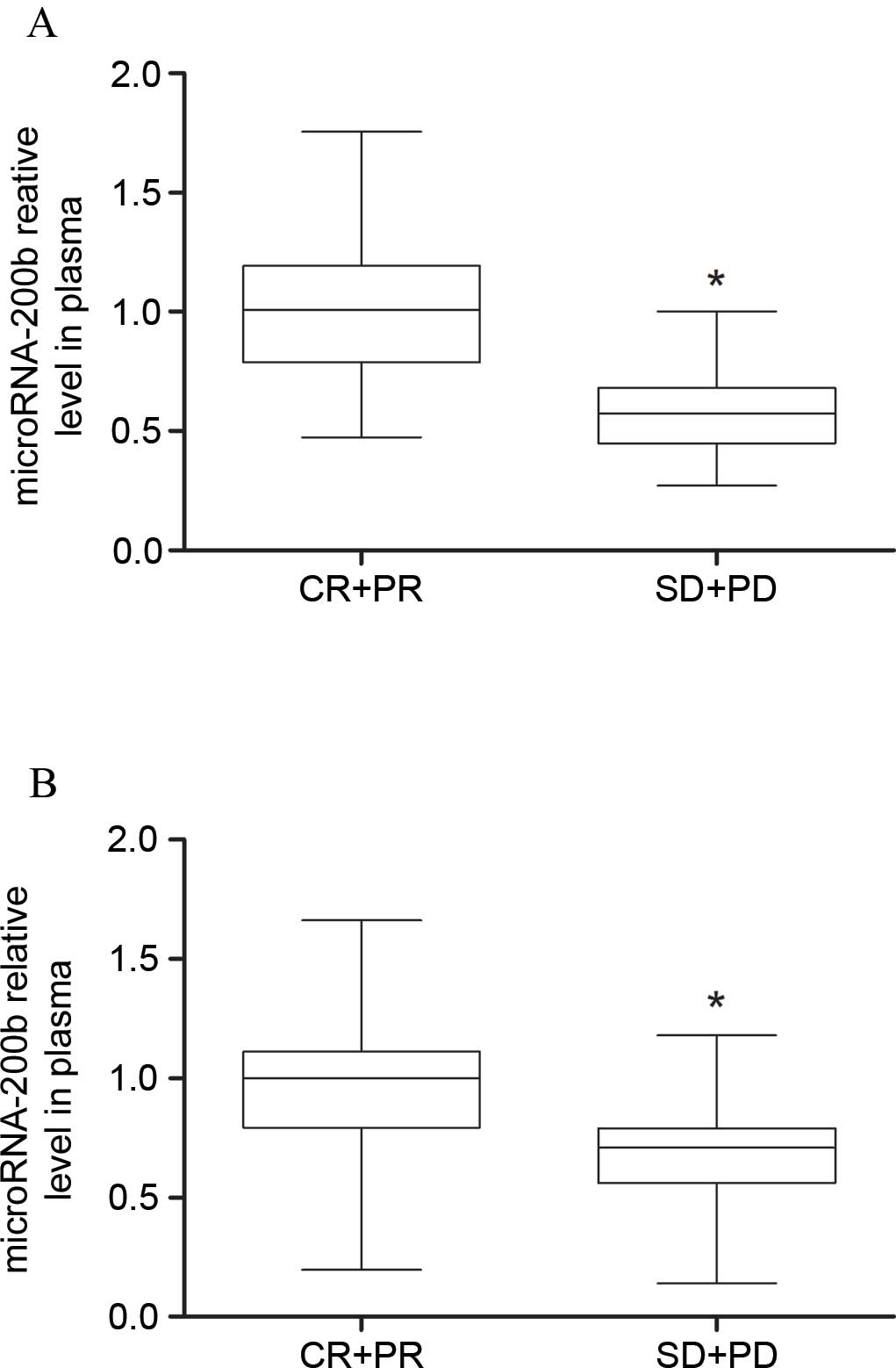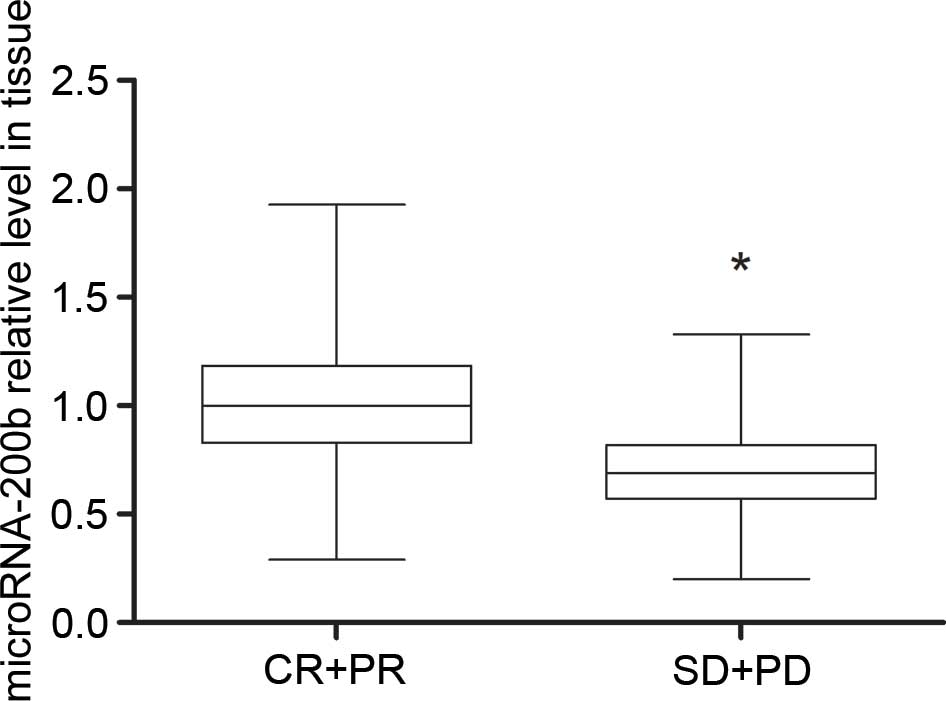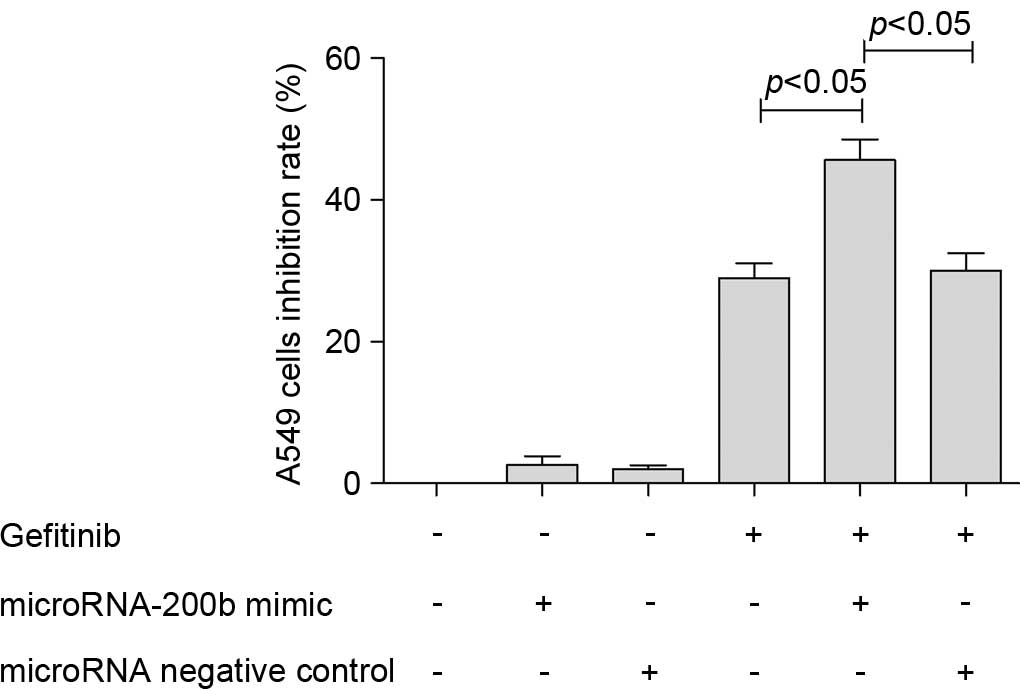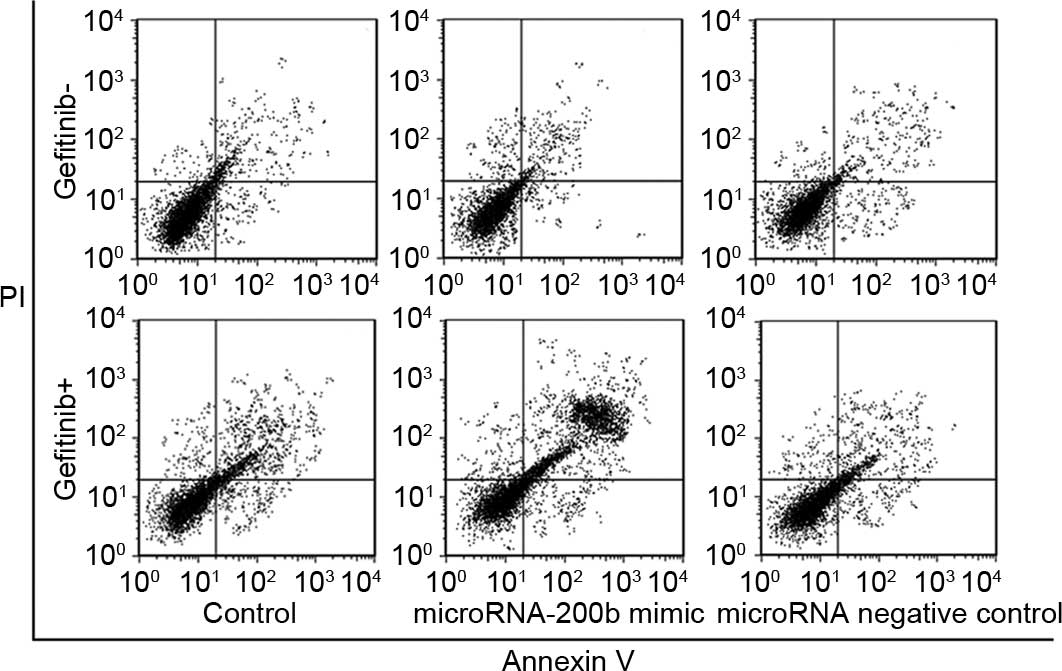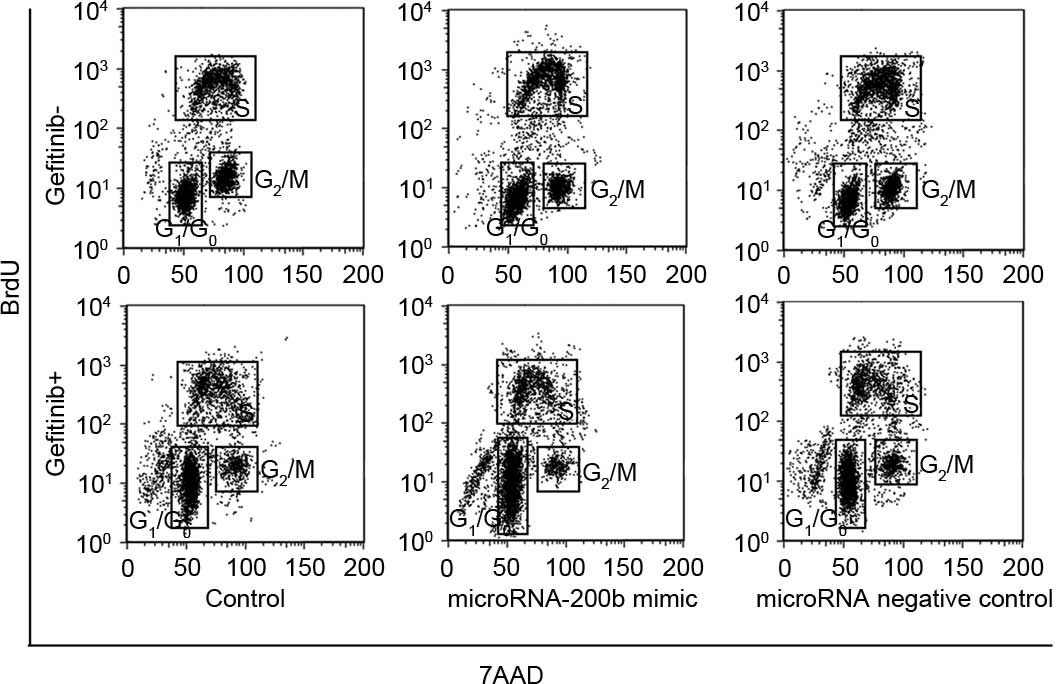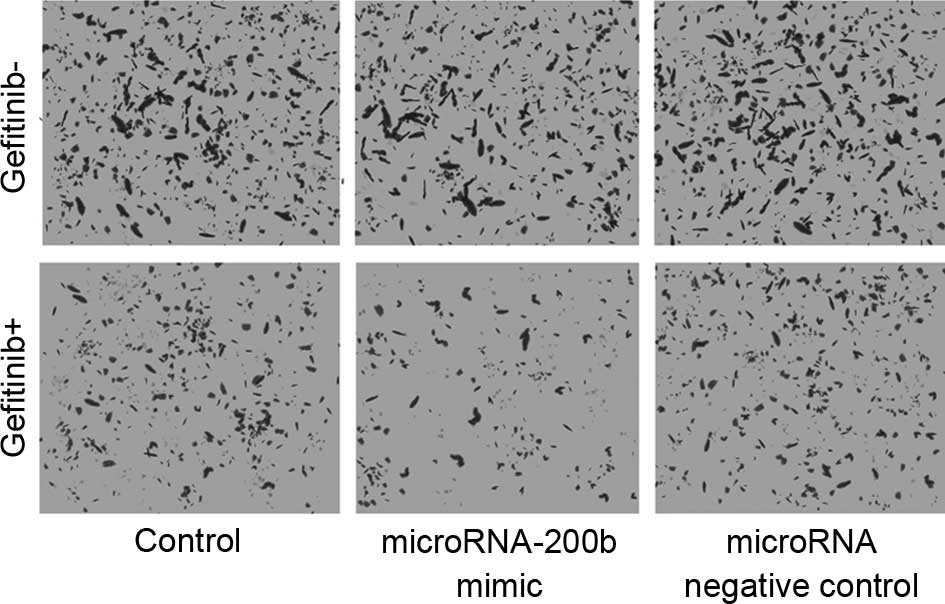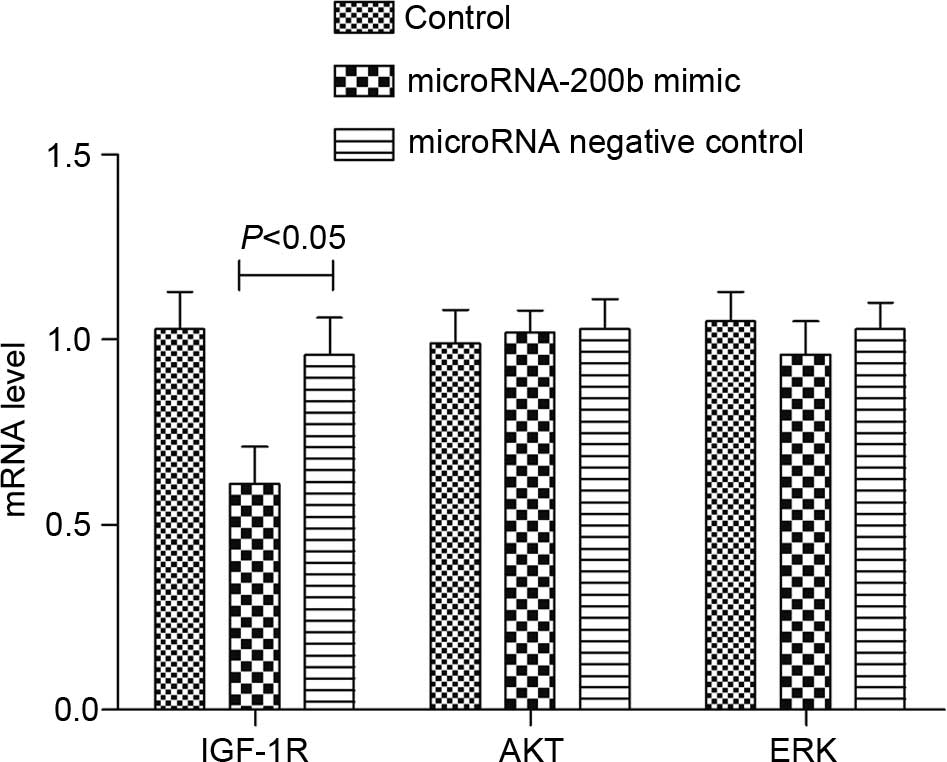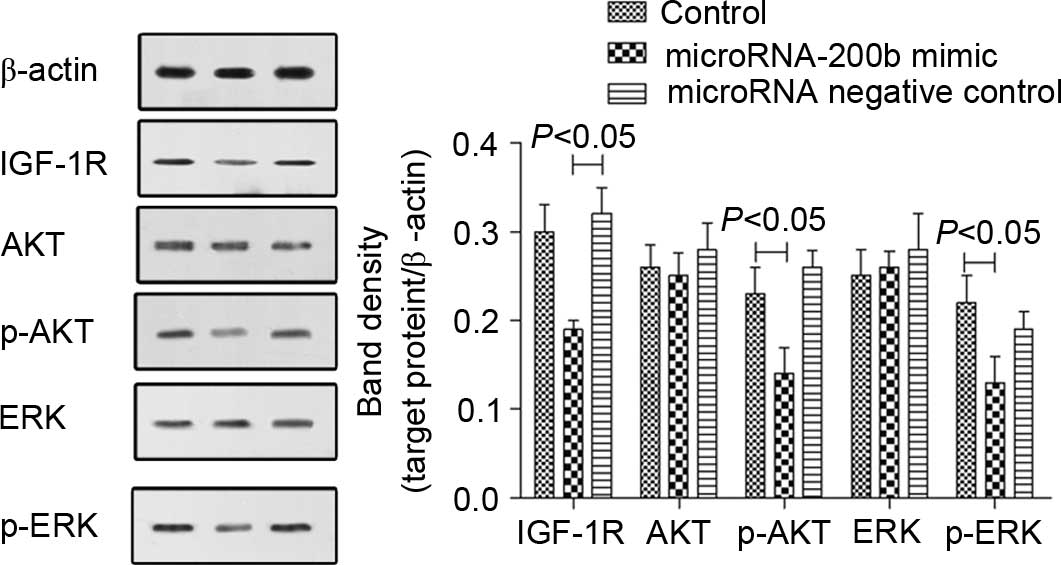Detection of microRNA-200b may predict the inhibitory effect of gefitinib on non‑small cell lung cancer and its potential mechanism
- Authors:
- Published online on: November 8, 2016 https://doi.org/10.3892/ol.2016.5365
- Pages: 5349-5355
Abstract
Introduction
Non-small cell lung cancer (NSCLC) is the most common respiratory system tumor clinically, accounting for ~80% of lung carcinoma cases (1). It is clinically characterized by rapid progression, strong invasiveness and a high mortality rate. Surgical resection is the current optimal therapy for NSCLC, but <50% of NSCLC patients can receive surgical treatment due to late diagnosis and advanced stage of disease (2). Therefore, with the exception of surgery, chemotherapy is also an essential strategy in the treatment of NSCLC, particularly for molecular targeted therapy (3,4). Epidermal growth factor receptor tyrosine kinase inhibitors (EGFR-TKIs) are the most well known molecular targeted anti-cancer drugs and are particularly effective in patients with activating EGFR mutations (5). Gefitinib is a specific EGFR-TKI, which is extensively applied in the treatment of non-small lung cells in clinical practice (6,7). Clinical studies (8,9) have reported that as first-line therapy, gefitinib significantly improves the survival in advanced EGFR mutation-positive NSCLC patients. However, for various reasons, such as EGFR gene mutant and tumor microenvironment changes, the sensitivity of NSCLC patients to gefitinib differs (10). In addition, previous studies demonstrated that certain patients develop resistance to gefitinib within a year (11). Thus, evaluating and predicting the effectiveness of gefitinib is crucial for adjusting therapeutic regimens and avoiding futile or low-efficiency treatment.
MicroRNA is a type of short-chain non-coding RNA that has been confirmed to be closely associated with the incidence, progression and drug resistance of tumors. For example, Fu et al found that microRNA-93 was significantly upregulated in cisplatin-resistant ovarian cancer cells (12). Dong et al found that microRNA-31 inhibits cisplatin-induced apoptosis in NSCLC (13). In addition, microRNAs can present stably in the serum or plasma and the techniques of quantitative detection for microRNA are ready for clinical practice. Thus, microRNAs have potential to become biomarkers that can be used for evaluating the sensitivity to chemotherapy. In previous years, extensive studies on microRNA-200b induced drug-resistance have been performed. Previous studies showed that microRNA-200b contributed to multi-drug resistance of small cell lung cancer (14), but at present, studies on the effect of microRNA-200b on NSCLC chemotherapy have been rarely reported. In particular, whether microRNA-200b level may affect the gefitinib treatment of NSCLC remains unclear.
Based on the aforementioned considerations, the present study was designed to investigate the association between microRNA-200b and the sensitivity of NSCLC patients to gefitinib. Furthermore, in vitro, the present study used A549 cells to confirm the results from clinical data and explore its potential mechanism involved with the factor-1 receptor pathway, as previous studies have shown that insulin-like growth factor-1 receptor (IGF-1R) is associated with acquired resistance of gefitinib (15).
Materials and methods
Patients and specimens
In total, 100 patients (43 males and 57 females; median age, 63 years) with pathologically confirmed advanced NSCLC admitted to the First Hospital of Lanzhou University (Lanzhou, China) between March 2012 and May 2014 were enrolled in the present study. Additional demographic data, including age, gender, histological type of tumor and clinical stage, are shown in Table I. All patients were administered with gefitinib orally (250 mg/day) and the effect of gefitinib was evaluated according to the Response Evaluation Criteria in Solid Tumors (RECIST) guidelines. In brief, the diameter of the tumors were calculated and analyzed, and patients were assessed for complete response (CR), partial response (PR), stable disease (SD) or progressive disease (PD). The tumor tissue samples were collected and stored in liquid nitrogen for additional analysis. Plasma samples were collected prior to and subsequent to therapy. The experimental protocols were approved by the Ethics Committee of The First Hospital of Lanzhou University, and all patients provided informed consent.
Cell culture
The human lung adenocarcinoma A549 cell line was obtained from the American Type Culture Collection (Manassas, VA, USA) and cultured at 37°C in a 5% CO2 atmosphere. All cells were maintained in Dulbecco's modified Eagle's medium (DMEM) supplemented with 10% fetal bovine serum (FBS; Gibco; Thermo Fisher Scientific, Inc., Waltham, MA, USA).
Reverse transcription quantitative PCR (RT-qPCR) for microRNA-200b detection
The microRNA of plasma specimens and tissue samples were extracted with the MiRcute miRNA Extraction-Separation kit [Tiangen Biotech (Beijing) Co., Ltd, Beijing, China], according to the manufacturer's protocol. Following measurement of the purity and concentration, reverse transcription of microRNA to cDNA was assessed using One Step PrimeScript miRNA cDNA Synthesis kit [Takara Biotechnology (Dalian) Co., Ltd., Dalian, China]. The reverse transcription system and conditions were also followed in accordance with the manufacturer's protocol; a no cDNA control and a no reverse transcription control were also used in the same reaction system. The obtained cDNA was amplified by RT-qPCR using SYBR® Premix Ex Taq™ II [Takara Biotechnology (Dalian) Co., Ltd.]. The reaction system and conditions were in accordance with the manufacturer's protocol. The microRNA-200b upstream primer sequence was 5′-GCGGCTAATACTGCCTGGTAA-3′. For normalizing the data of plasma microRNA, microRNA-16 was used as reference (upstream primer, 5′-CGCGCTAGCAGCACGTAAAT-3′). For normalizing the data of tissue microRNA, U6 small nuclear RNA (snRNA) was used as a reference (upstream primer, 5′-CTCGCTTCGGCAGCACA-3′). All downstream primers were universal 3′ miRNA primers. The relative expression level of microRNA-200b was calculated by the 2−ΔΔCq method (16,17), ΔCq=Cqtarget-Cqreference.
MicroRNA-200b upregulation
The microRNA-200b mimic was designed and synthesized by Invitrogen (Thermo Fisher Scientific, Inc.). Prior to transfection, A549 cells were routinely maintained and grew to 70% confluency. Subsequently, 100 nM microRNA-200b mimic and microRNA negative controls (NC) were transfected into cells by N-[1-(2,3-Dioleoyloxy)propyl]-N,N,N-trimethylammonium methyl-sulfate reagent (Roche Applied Science, Mannheim, Germany), according to the manufacturer's protocol. The transfection efficiency was assessed by RT-qPCR in a preliminary experiment using a similar protocol to the aforementioned protocol. For RT-qPCR analysis, the data in cells were normalized by U6 snRNA with the upstream primer sequence 5′-CTCGCTTCGGCAGCACA-3′.
Cell Counting Kit-8 (CCK-8) assay
Transfected and non-transfected A549 cells were plated at a density of 1.0×105 cells/well into a 96-well plate and incubated for 24 h at 37°C in a 5% CO2 atmosphere. Subsequent to being maintained for 24 h, all cells were treated with 0.1 µM gefitinib for 6, 12, 24 and 48 h. Subsequent to gefitinib treatment, 10 µl CCK-8 reagent (Dojindo Laboratories, Kumamoto, Japan) was immediately added to each well. After 4 h, the intensity of staining was monitored by SpectraMax i3 microtiter plate spectrophotometer (Molecular Devices, LLC, Sunnyvale, CA, USA) at 450 nm and the cell viability was estimated.
Flow cytometry analysis
Transfected and non-transfected A549 cells were treated with 0.1 µM gefitinib for 24 h and harvested. For cell cycle analysis, cells were fixed in 70% ethanol for 12 h and then incubated with bromodeoxyuridine (BrdU) and 7-amino-actinomycin D (7-AAD), according to the detailed protocol provided by BD Pharmingen BrdU Flow Kits (BD Biosciences, Heidelberg, Germany). The cell cycle was analyzed using FACSCalibur flow cytometer system (BD Biosciences). For apoptosis analysis, double staining (Annexin V-fluorescein isothiocyanate and propidium iodide) was performed and cells were also analyzed using the FACSCalibur flow cytometry system. The flow cytometry data were analyzed by CellQuest Pro software (BD Biosciences).
Transwell migration assay
Using 24-well Transwell chambers (Corning Incorporated, Corning, NY, USA) the migration of A549 cells was observed. According to the manufacturer's protocol, the lower chambers were filled with 500 µl DMEM supplemented with 10% FBS, and 1×104 cells and 100 µl DMEM without FBS were placed into the upper chambers. As routinely, Cells were cultured for 24 h at 37°C in the presence of 5% CO2 and then the cells that had invaded the lower surface of the microporous membrane of the Transwell chamber were fixed using methanol. Subsequent to being stained with crystal violet, the cells were quantified.
Quantitative PCR for IGF-1R, protein kinase B (AKT) and extracellular signal-related kinases (ERK)
Transfected and non-transfected A549 cells were cultured for 24 h; the total RNA in cells was extracted by TRIzol reagent (Invitrogen; Thermo Fisher Scientific, Inc.). RNA was reverse-transcribed to cDNA using PrimeScript® RT reagent kit [Takara Biotechnology (Dalian) Co., Ltd.]. The reverse transcription system was in accordance with the protocols of the kit. The synthesized cDNA was amplified by SYBR® Premix Ex Taq™ II kit [Takara Biotechnology (Dalian) Co., Ltd.]. Primers are shown in Table II, The reaction system and program was in accordance with the protocols of the kit. The relative expression of target IGF-1 mRNA was analyzed by the 2−ΔΔCq method (ΔCq=Cqtarget-CqGAPDH).
Western blot assay
Cells were lysed in radioimmunoprecipitation assay buffer on ice for 30 min and total proteins were extracted. In total, 25 µg of protein was boiled for 5 min, separated using 12% sodium dodecyl sulfate-polyacrylamide gel electrophoresis and transferred to a polyvinylidene fluoride membrane. Subsequent to being blocked with 5% nonfat dry milk in Tris-buffered saline and Tween 20, membranes were probed with anti-IGF-1R (dilution, 1:100; catalog no. ab39398), anti-AKT (dilution, 1:500; catalog no. ab8805), anti-ERK (dilution, 1:1,000; catalog no. ab196883), anti-phospho-AKT (dilution, 1:500; catalog no. ab8933), phospho-ERK (dilution, 1:100; catalog no. ab214362) and anti-β-actin (dilution, 1:10,000; ab8227) antibodies (Abcam, Cambridge, UK) overnight at 4°C. Subsequent to washing, membranes were incubated with Goat Anti-Rabbit IgG H&L (HRP) secondary antibody (dilution, 1:2,000; catalog no. ab97051) for 1 h. Incubated membranes were treated with ECL reagent (Applygen Technologies, Inc., Beijing, China). Please state the host and target animals, clonality, dilution and catalog number for the antibodies.
Statistical analysis
All data are reported as the mean ± standard deviation. The statistical significance of the differences was analyzed by one-way analysis of variance or least significant difference-t test using SPSS 15.0 software (SPSS, Inc., Chicago, IL, USA). For non-parametric statistics, Mann-Whitney U test was performed for comparison between the two groups. P<0.05 was considered to indicate a statistically significant difference.
Results
Low levels of microRNA-200b expression were detected in gefitinib-insensitive patients
According to the RECIST guidelines, 7 patients were classified as CR, 30 as PR, 28 as SD and 35 as PD. The present study defined CR+PR patients as gefitinib-sensitive patients (n=37) and SD+PD patients as gefitinib-insensitive patients (n=63). As shown in Table I, the age, gender, clinical stage and history of treatments showed no statistical difference between CR+PR patients and SD+PD patients. RT-qPCR results showed that the plasma microRNA-200b levels in SD+PD patients were lower compared with the CR+PR patients (P=0.0068), and the microRNA-200b levels in tissue samples of gefitinib-insensitive patients were also lower, compared with gefitinib-sensitive patients (P=0.0000075) (Figs. 1 and 2). It is suggested that detecting microRNA-200b level may reflect the sensitivity of NSCLC patients to gefitinib.
Upregulation of microRNA-200b increased the anti-proliferative effect of gefitinib
Subsequent to upregulating the microRNA-200b level of A549 cells through transfection with a microRNA-200b mimic, the present study found that the anti-proliferative effect of gefitinib on A549 cells increased. For the non-transfected A549 cells 24 h subsequent to treatment with 0.1 µM gefitinib, the cell inhibition rate was 20.8±3.2%, and for the A549 cells transfected with microRNA-200b mimic, the inhibition rate increased to 45.6±4.3%, showing a statistically significant difference (P=0.0071). However, transfection with microRNA NC did not affect the inhibiting effect of gefitinib on A549 cells (Fig. 3).
Upregulating microRNA-200b enhanced apoptosis induction and cycle arrest ability of gefitinib
Following a time period of 24 h subsequent to treatment of A549 cells using 0.1 µM gefitinib, the A549 cell apoptosis rate without transfection treatment was 18.3±2.9%, while the A549 cell apoptosis rate with upregulation of microRNA-200b was 29.2±3.1%, which was significantly increased compared with non-transfected A549 cells (P=0.032), as shown in Fig. 4. Cell cycle analysis showed that, subsequent to treatment with 0.1 µM gefitinib, the G0/G1 percentage of untransfected A549 cells was 38.6±4.2% and the G2/M percentage was 15.6±2.3%, suggesting that gefitinib could cause G0/G1 arrest of A549 cells. Following treatment of the A549 cells with upregulation of microRNA-200b with gefitinib, the G0/G1 percentage was 70.4±7.9% and the G2/M rate was 8.2±0.9%, indicating that upregulation of microRNA-200b could enhance arrest of G0/G1 phase induced by gefitinib. Similarly, the effect of microRNA NC on the cell cycle was not observed (Fig. 5).
Upregulating microRNA-200b increased the migration inhibition ability of gefitinib
As shown in Fig. 6, the Transwell chamber assay revealed that, following upregulation of microRNA-200b, gefitinib exhibited a markedly increased migration inhibition on A549 cells, which was manifested by a significantly reduced number of cells invading the lower surface of the polycarbonate membranes. The microRNA NC did not affect the migration inhibition ability of gefitinib.
Upregulating microRNA-200b affected the expression of IGF-1R and phosphorylation of AKT
RT-qPCR analysis revealed that, following the upregulation of the microRNA-200b level of A549 cells, the IGF-1R mRNA level in the cells was significantly reduced (P=0.012), but the mRNA levels of AKT and ERK were not changed (Fig. 7). The western blot analysis results were similar to those of RT-qPCR. The IGF-1R protein level was reduced, and AKT and ERK protein levels were not changed, but the levels of phosphorylated AKT and ERK were reduced (Fig. 8). The microRNA NC showed no effect on IGF-1R expression and AKT or ERK phosphorylation in A549 cells.
Discussion
The promotion and progression of NSCLC involves signal transduction abnormality of a variety of growth factors. Studies have confirmed that the growth of NSCLC is associated with EGF, vascular endothelial growth factor, fibroblast growth factor and IGF (18–20). Therefore, molecular targeted drugs can suppress the growth of NSCLC by inhibiting or activating the receptors or associated pathways of the aforementioned growth factors. EGFR is the specific EGF receptor, and studies have shown that overexpression of EGFR exists in more than half of NSCLC patients (18,21). EGFR has tyrosine kinase activity, and subsequent to binding with its ligand it can cause phosphorylation of downstream proteins and activate downstream signaling pathways, including the mitogen-activated protein kinase (MAPK) and phosphoinositide 3-kinase (PI3K)/AKT pathways (22,23). These pathways regulate tumorigenesis and tumor cell metastasis, including control over cell proliferation and apoptosis. Studies have shown that sustained activation of the MAPK and PI3K/AKT pathways can promote tumor cell division, inhibit cell apoptosis and promote invasiveness (24,25). Thus, EGFR is a crucial treatment target in NSCLC. The application of EGFR-TKI drugs can block the activation of EGFR downstream pathways, for example, inhibiting the MAPK and PI3K/AKT pathway, to play the role of inhibiting tumor cells (26). Gefitinib is one of the first generation EGFR-TKIs, which can effectively improve the management of NSCLC by inhibiting EGFR autophosphorylation and downstream signaling. However, the resistance to gefitinib limits its development and the majority of patients develop resistance within a year (12–16,18–27). Therefore, it is necessary to evaluate and predict the sensitivity of patients to gefitinib. Previous studies showed that microRNAs could regulate the response to gefitinib. Zhong et al (28) found that let-7a, hsa-miR-126 and hsa-miR-145 may enhance cytotoxicity induced by gefitinib in NSCLC. Another study showed that miR-34a rescues hepatocyte growth factor-induced gefitinib resistance in EGFR mutant NSCLC cells (29).
The present study revealed that the microRNA-200b levels were lower in those patients that experienced a poor curative effect of gefitinib. This indicated that detecting the microRNA-200b level may reflect the sensitivity of NSCLC patients to gefitinib. Furthermore, the current in vitro studies showed that upregulating the expression of microRNA-200b could increase the sensitivity of A549 cells to gefitinib. These results suggest that the inhibitory effect of gefitinib was associated with the expression of microRNA-200b. Previous studies have reported the association between microRNA-200b and chemotherapy resistance and its involved mechanism. For example, in a docetaxel-resistant human lung adenocarcinoma cell line, microRNA-200b was identified as the most downregulated microRNA. Additionally, a decreased microRNA-200b level was detected in lung adenocarcinoma patients treated with docetaxel-based chemotherapy and was associated with decreased sensitivity to docetaxel (14). The mechanism of microRNA-200b-induced chemotherapy resistance is complicated. Generally, the association between microRNA-200b dysregulation and cancer chemoresistance can be explained through the aspects of epithelial-mesenchymal transition, cancer stem cell maintenance, angiogenesis, apoptosis and cell cycle distribution (14,30). However, the present study focused on the IGF-1R pathway specifically.
IGF-1R is a transmembrane tyrosine protein receptor with tyrosine kinase activity, when binding with a ligand, it can activate the downstream EGFR pathways independent of EGFR, such as the PI3K-AKT pathway, to reduce the efficacy of EGFR-TKI drugs and even cause drug resistance (24,31). Therefore, to avoid the activation of pathways downstream of the EGFR pathway, such as the MAPK and PI3K/AKT pathways, it is particularly important to maintain the efficacy of gefitinib. In the present study, it was shown that upregulating the expression of microRNA-200b could reduce IGF-1R in the cells and inhibit phosphorylation of ERK and AKT. Therefore, it is considered that microRNA-200b may increase the inhibitory effect of gefitinib on NSCLC cells by inhibiting the expression of IGF-1R and reducing the activation of MAPK and PI3K/AKT pathways caused by IGF-1R.
The majority of previous studies reported that the target genes of the microRNA-200 family in tumors are the zinc finger E-box binding homeobox 1 and 2 with transcriptional regulation function (32). This study revealed that the increased level of microRNA-200b could reduce the expression of IGF-1R, but it could not identify that IGF-1R is the direct target gene of microRNA-200b. In fact, the prediction of bioinformatics tools does not confirm that IGF-1R is the direct target gene of microRNA-200b. Therefore, the pathway for IGF-1R expression affected by microRNA-200b remains to be further studied.
In conclusion, low expression of microRNA-200b exists in gefitinib-insensitive patients with NSCLC. Detecting the level of microRNA-200b may be useful to evaluate the effect of gefitinib on NSCLC patients. The increased microRNA-200b level can inhibit the activation of MAPK and PI3K/AKT pathways caused by IGF-1R, which aids improvement of the inhibitory effect of gefitinib.
References
|
Wang YW, Yin CL, Zhang HY, Hao J, Yang YY, Liao H and Jiao BH: High expression of forkhead box protein C2 is related to poor prognosis in human gliomas. Asian Pac J Cancer Prev. 15:10621–10625. 2014. View Article : Google Scholar : PubMed/NCBI | |
|
Islam KM Monirul, Shostrom V, Kessinger A and Ganti AK: Outcomes following surgical treatment compared to radiation for stage I NSCLC: A SEER database analysis. Lung Cancer. 82:90–94. 2013. View Article : Google Scholar : PubMed/NCBI | |
|
Gridelli C, Peters S, Sgambato A, Casaluce F, Adjei AA and Ciardiello F: ALK inhibitors in the treatment of advanced NSCLC. Cancer Treat Rev. 40:300–306. 2014. View Article : Google Scholar : PubMed/NCBI | |
|
Roemans P, Emami B, Cox J, Pacagnella A, Holsti L, Monteau M, Helle P, Comis R and Schaake C: Quality control in NSCLC treatment: A consensus report. Lung Cancer. 7:19–20. 1991. View Article : Google Scholar | |
|
Pircher A, Manzl C, Fiegl M, Popper H, Pirker R and Hilbe W: Overcoming resistance to first generation EGFR TKIs with cetuximab in combination with chemotherapy in an EGFR mutated advanced stage NSCLC patient. Lung Cancer. 83:408–410. 2014. View Article : Google Scholar : PubMed/NCBI | |
|
Han SY, Zhao MB, Zhuang GB and Li PP: Marsdenia tenacissima extract restored gefitinib sensitivity in resistant non-small cell lung cancer cells. Lung Cancer. 75:30–37. 2012. View Article : Google Scholar : PubMed/NCBI | |
|
Koizumi T, Agatsuma T, Ikegami K, Suzuki T, Kobayashi T, Kanda S, Yoshikawa S, Kubo K, Shiina T, Takasuna K, et al: Prospective study of gefitinib readministration after chemotherapy in patients with advanced non-small-cell lung cancer who previously responded to gefitinib. Clin Lung Cancer. 13:458–463. 2012. View Article : Google Scholar : PubMed/NCBI | |
|
Grigoriu B, Berghmans T and Meert AP: Management of EGFR mutated nonsmall cell lung carcinoma patients. Eur Respir J. 45:1132–1141. 2001. View Article : Google Scholar | |
|
Dhillon S: Gefitinib: A review of its use in adults with advanced non-small cell lung cancer. Target Oncol. 10:153–170. 2015. View Article : Google Scholar : PubMed/NCBI | |
|
Manegold C: New perspectives in the management of non-small cell lung cancer (NSCLC): Gefitinib (Iressa, ZD 1839). European Journal of Cancer Supplements. 2:34–39. 2004. View Article : Google Scholar | |
|
Jeong CH, Park HB, Jang WJ, Jung SH and Seo YH: Discovery of hybrid Hsp90 inhibitors and their anti-neoplastic effects against gefitinib-resistant non-small cell lung cancer (NSCLC). Bioorg Med Chem Lett. 24:224–227. 2014. View Article : Google Scholar : PubMed/NCBI | |
|
Fu X, Tian J, Zhang L, Chen Y and Hao Q: Involvement of microRNA-93, a new regulator of PTEN/Akt signaling pathway, in regulation of chemotherapeutic drug cisplatin chemosensitivity in ovarian cancer cells. FEBS Lett. 586:1279–1286. 2012. View Article : Google Scholar : PubMed/NCBI | |
|
Dong Z, Zhong Z, Yang L, Wang S and Gong Z: MicroRNA-31 inhibits cisplatin-induced apoptosis in non-small cell lung cancer cells by regulating the drug transporter ABCB9. Cancer Lett. 343:249–257. 2014. View Article : Google Scholar : PubMed/NCBI | |
|
MacDonagh L, Gray SG, Finn SP, Cuffe S, O'Byrne KJ and Barr MP: The emerging role of microRNAs in resistance to lung cancer treatments. Cancer Treat Rev. 41:160–169. 2015. View Article : Google Scholar : PubMed/NCBI | |
|
Tandon R, Kapoor S, Vali S, Senthil V, Nithya D, Venkataramanan R, Sharma A, Talwadkar A, Ray A, Bhatnagar PK and Dastidar SG: Dual epidermal growth factor receptor (EGFR)/insulin-like growth factor-1 receptor (IGF-1R) inhibitor: A novel approach for overcoming resistance in anticancer treatment. Eur J Pharmacol. 667:56–65. 2011. View Article : Google Scholar : PubMed/NCBI | |
|
Livak KJ and Schmittgen TD: Analysis of relative gene expression data using real-time quantitative PCR and the 2(−Delta Delta C(T)) method. Methods. 25:402–408. 2001. View Article : Google Scholar : PubMed/NCBI | |
|
Wang Y, Tang N, Hui T, Wang S, Zeng X, Li H and Ma J: Identification of endogenous reference genes for RT-qPCR analysis of plasma microRNAs levels in rats with acetaminophen-induced hepatotoxicity. J Appl Toxicol. 33:1330–1336. 2013.PubMed/NCBI | |
|
Grossi F and Tiseo M: Granulocyte growth factors in the treatment of non-small cell lung cancer (NSCLC). Crit Rev Oncol Hematol. 58:221–230. 2006. View Article : Google Scholar : PubMed/NCBI | |
|
Mukohara T, Kudoh S, Yamauchi S, Kimura T, Yoshimura N, Kanazawa H, Hirata K, Wanibuchi H, Fukushima S, Inoue K and Yoshikawa J: Expression of epidermal growth factor receptor (EGFR) and downstream-activated peptides in surgically excised non-small-cell lung cancer (NSCLC). Lung Cancer. 41:123–130. 2003. View Article : Google Scholar : PubMed/NCBI | |
|
Pallis AG and Syrigos KN: Epidermal growth factor receptor tyrosine kinase inhibitors in the treatment of NSCLC. Lung Cancer. 80:120–130. 2013. View Article : Google Scholar : PubMed/NCBI | |
|
Han X, Liu M, Wang S, Lv G, Ma L, Zeng C and Shi Y: An integrative analysis of the putative gefitinib-resistance related genes in a lung cancer cell line model system. Curr Cancer Drug Targets. 15:423–434. 2015. View Article : Google Scholar : PubMed/NCBI | |
|
Van Emburgh BO, Sartore-Bianchi A, Di Nicolantonio F, Siena S and Bardelli A: Acquired resistance to EGFR-targeted therapies in colorectal cancer. Mol Oncol. 8:1084–1094. 2014. View Article : Google Scholar : PubMed/NCBI | |
|
Hwang KE, Kwon SJ, Kim YS, Park DS, Kim BR, Yoon KH, Jeong ET and Kim HR: Effect of simvastatin on the resistance to EGFR tyrosine kinase inhibitors in a non-small cell lung cancer with the T790M mutation of EGFR. Exp Cell Res. 323:288–296. 2014. View Article : Google Scholar : PubMed/NCBI | |
|
Cao Z, Liu LZ, Dixon DA, Zheng JZ, Chandran B and Jiang BH: Insulin-like growth factor-I induces cyclooxygenase-2 expression via PI3K, MAPK and PKC signaling pathways in human ovarian cancer cells. Cell Signall. 19:1542–1553. 2007. View Article : Google Scholar | |
|
Kim MN, Lee KE, Hong JY, Heo WI, Kim KW, Kim KE and Sohn MH: Involvement of the MAPK and PI3K pathways in chitinase 3-like 1-regulated hyperoxia-induced airway epithelial cell death. Biochem Biophys Res Commun. 421:790–796. 2012. View Article : Google Scholar : PubMed/NCBI | |
|
Chang CY, Kuan YH, Ou YC, Li JR, Wu CC, Pan PH, Chen WY, Huang HY and Chen CJ: Autophagy contributes to gefitinib-induced glioma cell growth inhibition. Exp Cell Res. 327:102–112. 2014. View Article : Google Scholar : PubMed/NCBI | |
|
Xu R, Shen H, Guo R, Sun J, Gao W and Shu Y: Combine therapy of gefitinib and fulvestrant enhances antitumor effects on NSCLC cell lines with acquired resistance to gefitinib. Biomed Pharmacother. 66:384–389. 2012. View Article : Google Scholar : PubMed/NCBI | |
|
Zhong M, Ma X, Sun C and Chen L: MicroRNAs reduce tumor growth and contribute to enhance cytotoxicity induced by gefitinib in non-small cell lung cancer. Chem Biol Interact. 184:431–438. 2010. View Article : Google Scholar : PubMed/NCBI | |
|
Zhou JY, Chen X, Zhao J, Bao Z, Chen X, Zhang P, Liu ZF and Zhou J: MicroRNA-34a overcomes HGF-mediated gefitinib resistance in EGFR mutant lung cancer cells partly by targeting MET. Cancer Lett. 351:265–271. 2014. View Article : Google Scholar : PubMed/NCBI | |
|
Feng B, Wang R and Chen LB: Review of MiR-200b and cancer chemosensitivity. Biomed Pharmacother. 66:397–402. 2012. View Article : Google Scholar : PubMed/NCBI | |
|
Ochi N, Takigawa N, Harada D, Yasugi M, Ichihara E, Hotta K, Tabata M, Tanimoto M and Kiura K: Src mediates ERK reactivation in gefitinib resistance in non-small cell lung cancer. Exp Cell Res. 322:168–177. 2014. View Article : Google Scholar : PubMed/NCBI | |
|
Wu Q, Guo R, Lin M, Zhou B and Wang Y: MicroRNA-200a inhibits CD133/1+ ovarian cancer stem cells migration and invasion by targeting E-cadherin repressor ZEB2. Gynecol Oncol. 122:149–154. 2011. View Article : Google Scholar : PubMed/NCBI |



